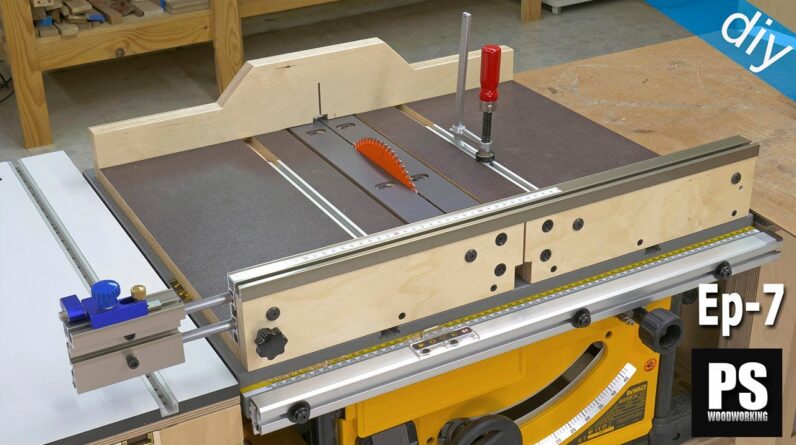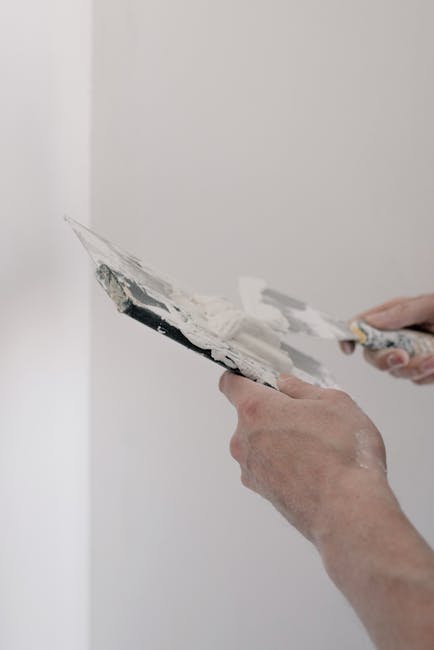
This is the seventh video in an eight part
series about my new woodworking workbench which I fitted with a bench table saw
and router table today I'm going to show you how to build and use this table saw sled with replaceable adjustable inserts the workbench has a gap in the bottom
of the table saw to store the sled and keep it handy when needed I've used trailer floor plywood to make the base of the sled it's a hard and sturdy kind of plywood
that's used as the name suggests for the interior of industrial vehicles it
has a layer of phenolic resin on both sides the side that's facing upward in the sled
is slip resistant which allows for better grip on the work pieces the bottom side
is smooth so the sled will slide better I've also used the same aluminum profile fence as
in the sliding carriage and the router table fence it's a very versatile profile that will let me use miter track stops and other accessories such as clamps I've installed a piece of wood acting
as an insert to achieve clean cuts at the exit point of the blade.
I
screwed it on using neck joint bushings but you could use any kind of metal washers to
avoid damaging the board when replacing the insert these are the inserts for the base they're made from HPL with grey melamine but we could have used MDF or acrylic boards
between five and seven millimeters thick I've machined some grooves to adjust them according to how thick the blade will use is I can remove them from the back
of the table by taking out the screws to adjust them it's best to raise the
blade as much as possible and tighten the screws leaving two tenths of a millimeter
between the insert and the teeth of the blade it's normal for the blades in these kinds of
table saws to vibrate a little when starting or stopping the motor here you can see how the blade
removes some material from the inserts on startup I've installed a soft start module in this saw and even though it's improved I haven't been able to solve it completely with these adjustable inserts I'll be able to adjust them as they wear out or deform by touching the blade I'm going to make a few cuts to see the sled in action this sled is ideal for making cross cuts
and medium and small size work pieces in a safe and accurate way I can cut pieces up to 60 millimeters high and 460 millimeters deep to cut larger work pieces
I have the sliding carriage the lower inserts make it so that the wood will
barely splinter at the exit point of the blade now I'm going to try with a much more sensitive board
a piece of chipboard with melamine on both sides funnily enough there's more splintering on the
upper side than on the lower one at the exit point maybe the blade was too low but
the inserts work like a charm I've installed some t-track profiles on the base of the sled that will let me hold and cut almost all kinds of work pieces safely I'll be able to use t-track clamps and hold down clamps I can also use hold down clamps
in the aluminum profile fence but only the ones that have a bolt
up to six millimeters in diameter these kinds of t-track clamps are very
comfortable when holding relatively high pieces besides they maintain the position once loosened making them very comfortable for repeated cuts they'll also allow me to hold
pieces so I can cut them at an angle this sled is very comfortable for these kinds
of cuts you only need to pre-mark the cut and align the cutting lines with the base inserts the hold down clamps will be very useful for holding work pieces to the aluminum profile fence and cut rabbets or make these kinds of cuts it's important to be careful with your
hands in these kinds of jobs if the sled doesn't have protection
at the exit point of the cut it wouldn't be a bad idea to make a
protector to install at the exit of the cut it would be easy to install by screwing it to the back plywood piece these hold down clamps will be perfect for holding very small work pieces and cut them safely just like with the sliding carriage here we can also make an attachment so that we can extend the miter track stop and cut larger work pieces we only need to insert it on one of the sides of the aluminum profile fence and lock it at the desired length with a tightening knob this stop is reversible and can be used on both on the left and on the right side of the profile fence we could even make larger attachments
to cut even longer work pieces and also use the one that I made some
days ago for the sliding carriage another interesting possibility
of this sled is to use it with a dado blade to make rabbits in all sorts of wooden work pieces you only need to adjust the inserts of
the base to the thickness of the blade and change the aluminum
profile fences wooden insert these types of blades are normally used to cut
grooves with this setup it's 6.3 millimeters thick to use it as a fence insert I can use any
kind of board that's 15 millimeters thick it will allow me to cut for example wooden tenons it will also allow me to make box joints both with the same dado blade or with a normal blade making the insert is easy you only need to
glue a piece of wood as a stop and place it away from the cutting line the same distance as the thickness of the blade we'll be using the height of the blade must be the same
as the thickness of the wooden pieces I'm going to run a few tests to show
off the process and the end result I think it's a little dangerous to
make these sorts of joints this way and I'm thinking of making a jig to mount on the
sled and make box joints in a faster and safer way now I'll show you how to make the table saw sled.

I'll start by cutting its base I'll mark the positions of all the holes needed for the screws and drill them with a column drill the next step is to cut the back part of the sled I mark the cuts following the plans and finish machining it with a bandsaw and a sanding disk I'll use the piece I've just machined to
mark the other nine millimeter plywood piece once it's cut I glue the two pieces together it's time to machine the front of the sled I've cut it to size and like earlier i'll
pre-mark and drill all the necessary holes once machined I can mount the sled by screwing the base and the front and back together I'll use the holes I'd already
drilled as a guide to drill the base now on to the central cut in the
sled first we should make sure if the blades adjusted to the miter
channels and bench table saw fence I lock the fence at the required
measurements and start cutting this is when we can leave the sled
centered in the table saw or off center once the cut has been made I
mark the position of each piece and remove the sled to continue machining first I'll make the rabbet for the base insert I'll do this little by little making sure
I don't cut too deep it's important that this rabbet is exactly as thick as the material we'll be using for the insert with the table saw in several runs I'll cut the grooves to insert the t-track profiles I'll finish the rabbit with the router table I'm also going to mark and machine the cut
necessary for the back piece of the sled it will let me place and remove the inserts easily I'm going to drill holes for the threaded inserts I'll screw them to the board with a
column drill to ensure they're square it's time to cut the aluminum
profile fence to size I'll also cut the center of the profile
so that I can place the wooden insert I'll use a miter saw and a blade to cut aluminum I'll finish the cut with an
oscillating multi-tool and a file before mounting the sled again I'll
drill holes for the joint bushings I'll also cut the t-track profile so that
I can screw them to the base of the sled I also cut the size the screws that will let me hold the aluminum profile
fence to the base of the sled even though it's not necessary to
use them I'm also going to place the screws that go on the underside of the sled it's time to cut the sliders that will
direct the sliding movement of the sled I'll cut some pieces of 8
millimeter HPL I have in my workshop I make sure they're the right size by inserting them in the miter channels of the bench table saw I mark and drill all the required
holes with a column drill I'm going to insert on the miter channels other pieces of the same HPL acting as spacers and with a little cyanoacrylate I glue the sliders to the bottom of the sled I've used the fence to leave the sled centered with a table saw top and squared with a saw blade once the glue is dry I remove the sled and place all of the screws using a self-centering drill bit I cut the inserts for the
sled from another piece of HPL I'll use my 3d router to
machine the adjustment grooves I prepared a jig with a mark in the center of the milling to make this process easier first I'll cut a through groove with a six millimeter bit then another one halfway
down with a 16 millimeter bit these grooves could have been made
with a handheld router and jigs I cut the bolts to size and
make sure everything's correct by placing the inserts on the base of the sled for the exit wooden insert I'm going to
cut four pieces so I can have replacements I cut them to size and make sure they
fit the gap in the aluminum profile fence with a bit I marked the positions of the holes for the screws and drilled them with a column drill now I can finish machining
the central cut on the table I'll do it in several runs for
every 10 millimeters approximately after measuring a small piece of
plywood I use it as a reference to glue on the measuring tape
to the aluminum profile fence I'm going to make the extendable part of the fence first I'll cut the steel pipes to size I'll make some holes in the
small profile with a bit 0.5 millimeters less wide than the bolt I'll be using I also use the column drill to thread the holes I'm also going to drill a hole that will allow me to lock this extendable fence as required I could have done this earlier and
it probably would have been easier i'm going to try to remedy this
with a wooden jig that helps me get straight holes I'm also going to need to thread the wood and the profile finally I'm going to cut and screw some plywood strips below the bench table saw to make it possible to store this sled in the plants I used two 18 millimeter plywood strips but I had a 15 millimeter piece in my shop that will let me get away without making a rabbet to achieve the required measurements I screw on two aluminum plates
in the back that will act as stops and screw the plywood strips to the bench there's one last consideration I'd like to
talk about the blade in these kinds of saws isn't usually at the center of the work table in this case there's a 10 millimeter difference the design of the plans has a central
cut right in the center of the base by using it in this saw the sled would be slightly off-center to one of the sides more or less like this I've modified the
design on the fly while I was making it so that the sled would be centered with the work table both systems are perfectly valid that's all for today in a few days I'll post a new video showing everything this mobile workbench can offer I'll also show how to make the drawers
and any other missing accessories see you soon
As an Amazon Associate I earn from qualifying purchases.







